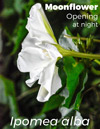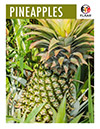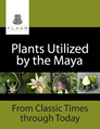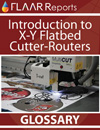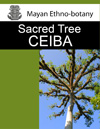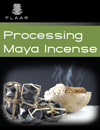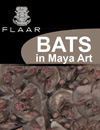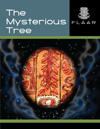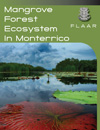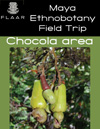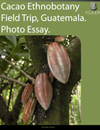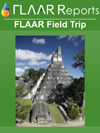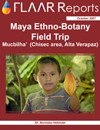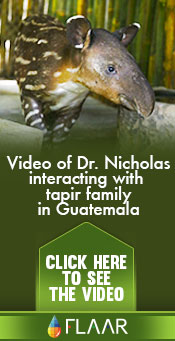Dozens of archaeological monographs including two or three PhD dissertations have been written on the 6 th -10 th century A.D. Cotzumalhuapa archaeological culture that occupies the piedmont area of the Departamento of Escuintla, Guatemala. Many of the larger sites such as El Baul and Bilbao are near the town of Santa Lucia Cotzumalguapa, about two or three hour drive downhill from Guatemala City.
The city is spelled with a g, Cotzumalguapa; the culture tends to be spelled with an h: Cotzumalhuapa.
The Cotzumalhuapa sculpture includes elements shared with Teotihuacan (Tlaloc for example), Classic Veracruz (skeleton characters), and other features shared with Late Classic and Post Classic Central Mexico. What is notable is that very few aspects of the Cotzumalhuapa sculpture share features with Maya art even though Bilbao is in Guatemala, not that far from Kaminaljuyu actually).
Cotzumalhuapan monumental sculpture dates from approximately AD 700 through AD 1000.
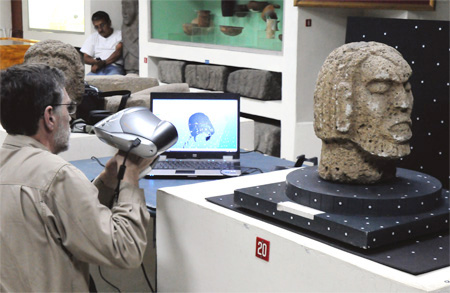 |
|
Dr.Nicholas Hellmuth at Museum of Cotzumalhuapa Sculpture testing the ZScanner 800 from Zcorp.
|
Etruscan, Phoenician, Greek, Mediterranean
I do not know of one single archaeologist today, trained at a major internationally respected university, that accepts Trans-Pacific or Trans-Atlantic influence on Mesoamerica. Of course boats from Nordic areas crossed over to Canada and Eastern America, but we have no evidence any such boats landed in Mexico or Central America. Besides, the Bilbao culture is on the Pacific Ocean side of Guatemala, not anywhere near the Atlantic Ocean (though it is worth pointing out that most of the bearded Mediterranean (Phoenician-looking) images that are in Mexico are precisely in Veracruz, which is on the Atlantic Coastal of Mexico).
So we have a culture (Cotzumalhuapan) with a typical pre-Columbian ballgame (filled with scenes of ballplayers being brutally sacrificed), with typical motifs such as flowering vines (common at Chichen Itza ballcourt sculptures of Yucatan, Mexico), and normal Mesoamerican deities (Tlaloc), yet here are also three portrait heads whose characteristics look more Greek or Etruscan or Phoenician: at least one or two of these heads looks far more like what you would expect from Northern African coast of the Mediterranean (namely a DNA soup of all the merchant sailors that left their traces around the southern coast of that sea).
I am fully aware that if you search any large sample of portraits you can always find some unusual visages, these here look so obviously Mediterranean and so definitely non-Mesoamerican that it prompts additional thought.
Further research and analysis of the iconography of Bilbao
Neither I nor FLAAR suggest these portrait faces actually represent Phoenicians, but these portraits certainly raise questions. Thus I hope that students will do a study of the iconography of the full corpus of Bilbao art. The excellent work of Lee Parsons and Oswaldo Chinchilla are first and foremost archaeological studies: Bilbao calls for a full scale iconographic study. For example, it would also be nice to have a thesis on hair styles: the “braided” hair is quite common to these Bilbao characters, but surely can be found elsewhere in Mesoamerica (and not only in Africa).
Over the next month or so we will issue additional photo albums because FLAAR photographs are intended to be available for thesis and dissertations.
Museo de Cultura Bilbao, Cotzumalguapa
This is an informative private museum of monumental stone sculpture and artifacts (open to the public) on the property of the Finca Las Ilusiones. FLAAR has been doing photography in the Bilbao area since the 1970's and during the 1980s-1990's we have twice photographed the Bilbao ballcourt and other sculptures in the museum in Berlin with the quality of Zeiss lenses on Hasselblad cameras. All our recent photograph are the same camera, same Zeiss lenses, but now with PhaseOne P25+ digital quality.
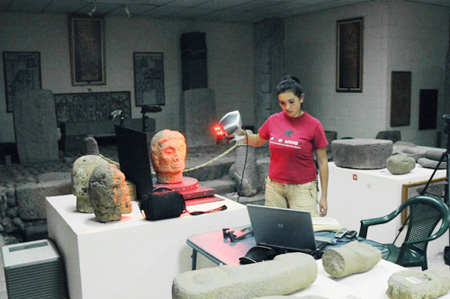 |
|
Here is Camila Morales (anthropology/archaeology volunteer student with FLAAR). She learned to scan antropological pieces at Museum of Cotzumalhuapa Sculpture.
|
Acknowledgements
We thank the family Muñoz for permission to do digital photography and 3d scanning in the museum. FLAAR is one of the foremost evaluators of digital imaging equipment in the Americas. We are currently testing and evaluating the ZScanner 800 from ZCorp, provided courtesy of ZCorp of America. We thank the custodian of the museum, Agusto Hernandez for general assistance during the many days that we were photographing and scanning.
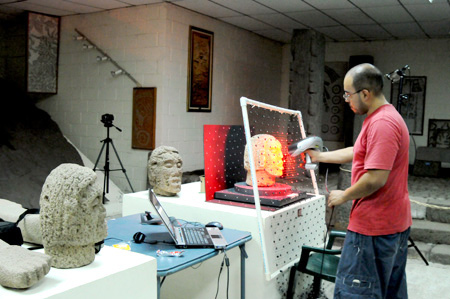 |
|
Here Eduardo Sacayon (biologist and photographer), at Museum of Cotzumalhuapa Sculpture. FLAAR actually is testing the ZScanner 800 from Zcorp, provided from Zcorp.
|
First posted late January 2010, after a second photography session in the Museo de Cultura Cotzumalguapa (mid-2009 and then again in December 2009).



